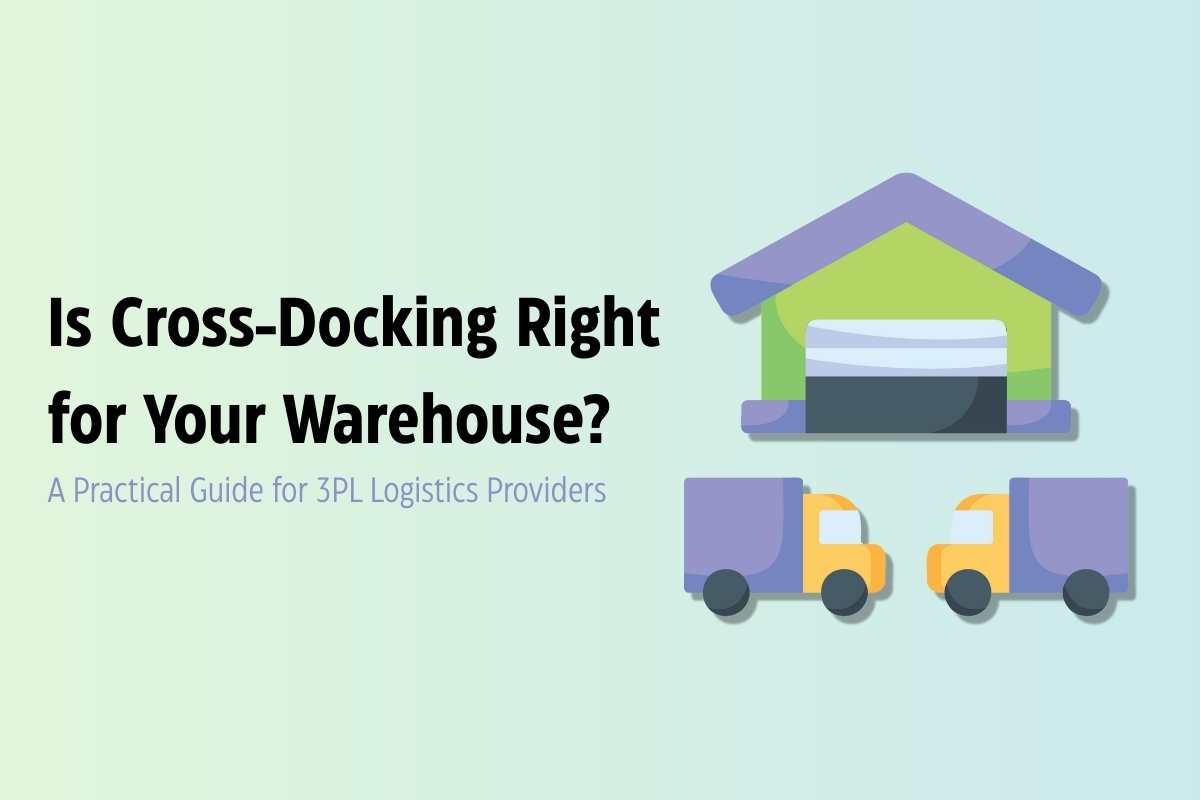At Mercurius IT, we work hand-in-hand with logistics providers to strengthen their warehouse operations using Microsoft Dynamics 365 and our tailor-made 3PL Dynamics.
Cross docking keeps cropping up as a hot topic in the logistics world. I’m going to break down what cross docking really means, the good bits, the not-so-good bits, and help you figure out if it’s a smart move for your business.
Get the lowdown on whether cross docking could be your ticket to leaner, faster operations without the headache of implementation mishaps.
What is Cross Docking in Warehousing?
Cross docking is a clever warehouse trick where incoming goods zip straight to outbound transport with little to no storage in between. Rather than putting stuff into inventory, it’s sorted at a central location and shipped out—often within hours.
The whole point is to cut down on handling, speed up delivery, and slash the need for storage space. You’ll spot cross docking across retail, food delivery, pharmaceuticals, and the car industry.
Explore how this streamlined approach could shave days off your delivery times and pounds off your bottom line.
What is Microsoft PowerApps?
PowerApps is a low-code development solution part of Microsoft’s Power Platform.
It provides capabilities to build custom business applications without the need for extensive coding knowledge.
It’s designed for speed, flexibility and integrations – so teams can quickly create tailored solutions that fit their needs and connect to other applications in the Microsoft ecosystem such as Teams, Office365, SharePoint, Dynamics 365 and hundreds of third-party connectors for external systems.
Power Apps utilizes a well-defined data model to build robust applications, ensuring structured solutions for healthcare providers.
Apps built with Power Apps can run on mobile devices, tablets or desktops and can be customised to meet specific needs such as tracking lab samples, managing clinical trials or digitising patient intake forms.
Model driven apps enable the creation of structured applications focused on data models and business processes, ideal for complex healthcare solutions.
The beauty of this solution is the low-code nature. It enables healthcare professionals and IT teams to work together more closely, bring ideas to life faster and more cost effectively.
Introduction to Cross Docking
Cross docking is a nifty logistics process where we move goods directly from incoming vehicles to outgoing ones, cutting storage time and handling costs to the bone.
This leads to significant cost savings by reducing storage and labour costs, while also improving time efficiencies. It’s a key bit of supply chain magic that helps companies run a tighter ship and trim costs.
By dodging the need for storage, companies can manage inventory better, cut holding costs, and see exactly what’s happening across their supply chain.
It’s brilliant for businesses with high-volume, fast-moving products, as it lets them quickly adapt to demand changes and get products to market faster.
Ready to see how cross docking could transform your logistics operations from clunky to streamlined overnight?
Cross Dock Facility
A cross dock facility is a specialised type of warehouse or distribution centre designed to streamline the transfer of goods from incoming vehicles directly to outgoing vehicles, minimising storage time and handling costs.
These facilities are a cornerstone for companies that need to move large volumes of goods quickly and efficiently, such as retailers, manufacturers, and logistics providers.
By leveraging a cross dock facility, businesses can significantly reduce their inventory holding costs, lower transportation costs, and enhance their overall supply chain visibility.
This efficient setup ensures that goods spend minimal time in storage, allowing for faster turnaround and more responsive supply chain operations.
Cross Docking Warehouse Design
The design of a cross docking warehouse is crucial to its operational success.
A well-thought-out layout facilitates the smooth and efficient movement of goods from incoming to outgoing vehicles, ensuring minimal storage time and handling costs.
Here are two key design approaches:
Types of Cross Docking
There are a few flavours of cross docking to choose from. Cross docking involves a process that eliminates the need for storage by facilitating the immediate transfer of goods from incoming transportation to outgoing shipments.
Pre-distribution cross docking bundles products from multiple suppliers into a single shipment. Post-distribution cross docking sorts and allocates products to specific customers or destinations.
Continuous cross docking keeps products flowing through a facility with minimal storage time. Each type has its own pros and cons, and companies need to match their specific needs with the right cross docking strategy.
Find the perfect cross docking approach for your business and watch your efficiency soar while costs plummet.
Continuous Cross
A continuous cross dock design focuses on maintaining a constant flow of goods through the warehouse, with little to no storage time.
This setup is ideal for companies that need to move high volumes of goods quickly and efficiently.
By keeping products in motion, businesses can reduce storage costs and improve overall supply chain efficiency.
Consolidation Cross
A consolidation cross dock design involves combining goods from multiple suppliers or locations into a single shipment.
This approach is perfect for companies looking to reduce transportation costs and enhance supply chain efficiency.
By consolidating shipments, businesses can optimise their logistics process, lower transportation costs, and improve coordination across the supply chain.
Cross Docking Operations
Running a cross docking operation means keeping incoming and outgoing shipments in perfect harmony, while cleverly managing inventory and space. Cross dock facilities typically have loads of dock doors so goods can come in and go out at the same time.
Using automated kit like conveyor belts and sorting machines can make the whole process smoother and cut labour costs.
To nail cross docking operations, you need spot-on planning and coordination, accurate demand forecasting, tight inventory management, and smart transport planning.
When companies get their cross docking operations right, they slash costs, boost efficiency, and edge out the competition.
Take control of your cross docking strategy today and reap the rewards of a leaner, more responsive supply chain tomorrow.
What Are the Advantages of Cross Docking?
Cross docking can deliver some real-world perks when it’s used in the right setting. Here’s what you stand to gain:
Cross docking benefits include enhancing supply chain efficiency by reducing storage costs and speeding up delivery times.
1. Lower Storage Costs
Since items don’t hang about for long, we can seriously cut down on inventory carrying costs, shelving, racking, and warehouse space costs. This often means a smaller, cheaper warehouse footprint too.
2. Quicker Turnaround
Cross docking enables the direct transfer of goods from receiving to outbound trucks, ensuring minimal storage time and quicker turnaround. It’s perfect when you’re dealing with pre-labelled or pre-packaged products that are ready to ship straight away.
3. Less Inventory on Hand
Working with fewer stored goods means less cash tied up in inventory and lower inventory costs, allowing products to reach their final destination more efficiently. It also cuts the risk of stock getting old or outdated before it sells.
4. Reduced Handling
Fewer touchpoints mean fewer chances for damage or loss, making your inventory handling better overall.
Implementing efficient operations is crucial for successful cross-docking, as streamlined processes and effective management systems optimise the layout and function of the facility.
You’ll also save on labour costs that would otherwise go on putting away and retrieving stock.
Put these advantages to work for your business and watch your warehouse transform from a cost centre to a competitive edge overnight.
5. Better Inventory Management
Cross docking offers significant advantages in inventory management by reducing inventory holding costs, enhancing supply chain visibility, and enabling more accurate demand forecasting.
By adopting cross docking, companies can lower their inventory levels, cut storage costs, and boost overall supply chain efficiency.
This method allows businesses to respond swiftly to changes in demand, minimising the need for excess inventory and improving product quality.
In terms of supply chain management, cross docking streamlines the logistics process, reduces transportation costs, and enhances overall efficiency.
Companies can move away from traditional warehousing, lower labour costs, and gain better visibility into their supply chain operations.
Additionally, cross docking improves customer service by enabling rapid delivery, reducing lead times, and ensuring high product quality.
Key benefits of cross docking include:
-
Reduced inventory holding costs
-
Improved supply chain visibility
-
Increased efficiency
-
Reduced labour costs
-
Enhanced customer service
-
Rapid delivery
-
Shorter lead times
-
Better product quality
Overall, cross docking is a powerful strategy for companies aiming to improve their supply chain management, reduce costs, and gain a competitive edge in the market.
By streamlining the logistics process and enhancing efficiency, cross docking helps businesses achieve operational excellence and deliver superior customer service.
Inventory Bottlenecks Slowing You Down?
What Are the Disadvantages of Cross Docking?
While the benefits are tempting, cross docking isn’t everyone’s cup of tea. Here are some possible snags:
Cross-docking can lead to lower operational costs related to storage and inventory, but it also involves significant costs associated with advanced technologies and skilled labour required to operate the facilities effectively.
1. Dependence on Timing
Cross-docking needs tight coordination between suppliers, carriers, and warehouse teams to sync incoming transport and outbound shipments. If inbound deliveries run late, your outbound schedule takes a hit.
2. Not Suitable for All Goods
Products that need inspection, assembly, repackaging, or special storage conditions, plus time-sensitive goods, might not work well with this method.
Large shipments can also pose challenges, as they often need to be deconsolidated into smaller, more manageable deliveries for efficient distribution.
3. Limited Margin for Error
You need spot-on shipment data, real-time visibility, and clear distribution instructions for cross-docking to work. Any mismatch between what’s needed and what’s supplied can lead to missed deliveries or a clogged warehouse floor.
Utilising predetermined distribution instructions ensures that logistics are planned based on known end customers and destinations, minimising handling and expediting product movement.
Know these pitfalls before you leap into cross docking and save yourself the headache of an expensive failed implementation.
What Are the Challenges of Cross Docking?
Getting cross docking up and running comes with its own hurdles:
A successful cross docking operation requires real-time visibility into supply and demand, accurate inventory management, and coordination with supply chain partners.
Utilising integrated technology solutions, like Microsoft Dynamics 365 ERP, enhances operational control and streamlines logistics, ultimately leading to increased customer satisfaction and profitability.
From ensuring that the right products are available at the right time to managing the flow of goods efficiently, there are several factors to consider.
1. Technology Requirements
You’ll need a warehouse management system (WMS) with real-time tracking, automated alerts, and dock scheduling features to manage incoming and outgoing goods effectively.
These technologies are crucial for enabling companies to enhance supply chain visibility and streamline processes, ultimately leading to faster product delivery and reduced costs. Without this tech backbone, you’ll struggle to keep everything moving smoothly.
2. Operational Discipline
Staff need clear processes and proper training to make sure goods are promptly received, sorted, and sent out. Cross docking demands a completely different mindset from traditional warehousing.
3. Carrier Reliability
Late or early arrivals can mess up dock availability and put pressure on warehouse resources. Close coordination with transport providers is vital to keep operations ticking along nicely.
4. Space Allocation
Though you’ll need less storage, you still need space for temporary staging, sorting, and loading. Proper planning is essential to avoid congestion or safety hazards.
Tackle these challenges head-on with the right technology and training, and you’ll unlock the full potential of cross docking for your business.
Cross Docking vs. Traditional Warehousing
Cross docking and traditional warehousing are two completely different approaches to managing inventory and distribution.
Traditional warehousing stores goods for ages, while cross docking moves them directly from incoming to outgoing vehicles with hardly any storage time.
Cross docking reduces the need for warehouse storage and associated costs, which allows companies to cut expenses while meeting customer demands for faster delivery times in a competitive market.
Cross docking offers several advantages over the old-school approach, including lower storage costs, reduced labour costs, and better inventory management.
That said, cross docking isn’t right for every product or company, and traditional warehousing might be more suitable in some cases.
Companies need to think carefully about what they actually need before choosing between cross docking and traditional warehousing.
Find the perfect balance between these approaches and create a hybrid system that gives you the best of both worlds.
Industries that Use Cross Docking
Cross docking pops up in all sorts of industries, including retail, manufacturing, and logistics. Retail cross docking streamlines distribution, letting retailers quickly respond to demand changes and get products to market faster.
Manufacturing companies use cross docking to manage their inventory and supply chain operations, while logistics companies use it to provide efficient, cost-effective transport services.
Distribution centres play a pivotal role in these processes, managing large incoming shipments from suppliers and dividing them into smaller deliveries for stores or customers, thus enhancing the movement of goods and improving delivery times.
Other industries that love cross docking include food and drink, pharmaceuticals, and automotive. By using cross docking, companies in these sectors can boost efficiency, cut costs, and gain a competitive edge.
Cross docking is a crucial bit of supply chain wizardry, and we expect its use to keep growing in the years ahead.
See how industry leaders in your sector are already leveraging cross docking to outpace their competition and delight their customers.
What is an Example of Cross Docking?
A classic example is in grocery distribution. A supermarket chain might receive pallets of fresh produce from several suppliers early doors.
These pallets are unloaded at a cross docking terminal, quickly sorted based on what stores need, and loaded directly onto outbound vehicles. The goods reach store shelves the same day, keeping them fresh and reducing waste.
A cross dock warehouse is a specialised logistics facility designed for the rapid transfer of goods, minimising storage time and enhancing efficiency in the supply chain.
Another example is in retail, where shipments from various vendors arrive at a cross-docking facility, are grouped by destination, and then sent directly to stores or customers without hanging about in storage.
Try imagining how these real-world applications might translate to your business for immediate efficiency gains.
Is Cross Dock a good idea?
Cross docking works a treat when demand is steady, lead times are predictable, and products don’t need special handling. Businesses that operate with high volumes or rely on just-in-time delivery typically see the most value and competitive advantage.
Cross docking makes omnichannel fulfilment more efficient, particularly in situations involving high-volume distribution, seasonal sales fluctuations, or perishable inventory.
That said, the success of cross docking hinges on having the right tools, reliable logistics partners, and a clear view of product movement. Without these, the risks can outweigh the rewards.
Assess your current operations against these criteria to see if cross docking could be your next smart move toward operational excellence.
How 3PL Dynamics Helps the Supply Chain
With 3PL Dynamics, businesses get warehouse management tools designed to support strategies like cross docking services.
From advanced dock scheduling to real-time order tracking, the system helps users manage goods movement with greater clarity and control.
Features such as barcode scanning, location management, and workflow automation support the day-to-day needs of logistics service providers.
The shipping process is crucial in minimising product damage and improving delivery efficiency, especially in the context of cross-docking operations.
As a Microsoft Solutions Partner and reseller of 3PL Dynamics, Mercurius IT supports warehouse and logistics providers with solutions that help improve visibility and responsiveness across operations.
If you’re exploring ways to improve your warehouse performance or considering a move towards cross docking, we can help assess whether 3PL Dynamics fits your model.
Book a no-obligation discovery call today to see how our solutions could transform your logistics operations from a cost centre to a competitive advantage.







